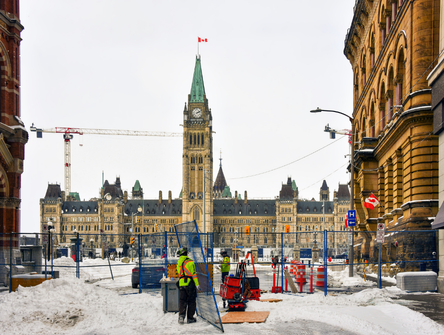A turning point for Indigenous law in Canada?
Observers say a recent Supreme Court decision upholding a Yukon First Nation’s residency requirement is significant for defending Indigenous communities’ right to self-govern without undue interference from external legal frameworks.

A Supreme Court of Canada decision that upheld a residency requirement for First Nations leadership positions marks a potential turning point in Canadian legal history.
In a 4-3 ruling, the court found the requirement is protected under the Aboriginal and treaty rights set out in Section 25 of the Charter because it preserves “Indigenous difference.”
The case involved the self-governing Vuntut Gwitchin First Nation (VGFN) in the Yukon, which adopted its own constitution in 1993. It included a residency requirement for all chiefs and councillors to reside on their settlement land, or to relocate there within 14 days of their election.
Cindy Dickson, a member of the First Nation, lives 800 km away in Whitehorse because her son needs medical care not available on the settlement land. The village of Old Crow, where the VGFN government is located, is a fly-in community. Dickson wanted to stand for election as councillor, and challenged the residency requirement.
Six of the seven justices found that while the Charter applies to this self-governing First Nation under Section 32(1), and that Dickson’s section 15(1) right was infringed, the four justices in the majority found that in this case, Section 25 applied to the residency requirement.
“Tied to ancient practices of government that connect leadership of the VGFN community to the settlement land, the residency requirement protects Indigenous difference and, pursuit to s.25, cannot be abrogated or derogated from by Ms. Dickson’s individual Charter right with which it is in irreconcilable conflict,” Justices Nicholas Kasirer and Mahmud Jamal wrote for the majority.
Alison Carstairs, who practices in Vancouver and is the communications officer for the CBA’s Aboriginal Law Section, says the decision is significant and marks a potential turning point because the majority has defended the inherent rights of Indigenous communities to govern themselves without undue interference from external legal frameworks.
“Cindy Dickson's challenge to the residency requirement may be seen to threaten the very foundation of Indigenous self-governance, undermining the autonomy and sovereignty that these peoples' communities have fought so hard to reclaim,” Carstairs said.
“The majority’s stance may be that they cannot allow the Charter to become a tool for eroding the rights of Indigenous peoples, nor should the court be seen to impose such legal standards on traditional Indigenous governance structures.”
The decision goes on to say that because Section 25 is intended to protect rights associated with Indigenous difference, such as cultural differences, prior occupancy and sovereignty, whether or not those differences warrant the provision’s protection will hinge on whether it protects or recognizes those interests.
“In short, a party seeking the protection of s.25 for a right alleged to be an ‘other’ right must establish both the existence of the right and fact that the right protects or recognizes Indigenous difference,” Kasirer and Jamal wrote.
The decision creates clarity that the Charter does apply to the newer-negotiated modern-day treaties, says Merle Alexander, principal lawyer at Miller Titerle and Company in Victoria.
“All of us in the legal profession, including in the Indigenous community, are trying to thread that needle between collective and individual rights,” he says.
“We’re still very much in the infancy of our understanding of Aboriginal law.”
But as the understanding of its application grows, so too does the appreciation of the fact that there is much more of a spectrum of Indigenous rights — some of which are individual, familial and part of small collectives, as well as others at the First Nation level.
As a result, he says that in a treaty older than Vuntut Gwitchin’s, there could have been a very different result.
For nations drafting their own legal orders, this decision drives home things they need to take into consideration when uplifting their own law and exercising their rights under self-governance.
“I really took away that it requires a greater mindfulness of how Indigenous people need to have precise clarity in the laws they are drafting,” Alexander says.
“In British Columbia, where we’re very involved in the implementation of UNDRIP… we’re really mindful of the text of statutes in a way that is so far uncommon in the country.”
When the courts take prescriptive look at things, he says there will be some frustration that applying the Charter feels superimposed and perhaps paternal, but the key to navigating that is to draft with clarity.
With regard to the fleshing out of Section 25 jurisprudence, Alexander says it’s a reflection of the tremendous amount of work to be done in understanding Indigenous law, and the fact that practicing in this area calls for a great deal of humility.
Emmett Macfarlane, a constitutional law professor at the University of Waterloo, says that the court’s reasoning around the purpose and nature of Section 25 raises questions about gender equality rights set out in Section 28, given the debate among legal scholars as to whether the former is merely an interpretive provision, or if it has some kind of substantive effect.
“This judgment does quite a bit to suggest they can’t simply say Section 28 is just an interpretative clause,” Macfarlane says. “At the very least, they’re going to have to explain that.”
This becomes especially relevant in the ongoing court challenges around Quebec’s Bill 21, which prohibits public servants and provincial employees from wearing religious symbols.
“This decision is a pretty major indicator that if the court decides Section 28 is merely interpretive, they’re going to have to actually distinguish why that’s the case with Section 28 and not Section 25,” Macfarlane says.
He says that lends a lot of weight to the Section 28 argument, that with respect to Bill 21, the notwithstanding clause may not apply if the legislation is found to disproportionately impact women.
Still with women, Carstairs says there’s a need to recognize that this court challenge has contributed to change.
“It wasn’t too long ago that Indigenous peoples were not allowed to appoint lawyers or to be lawyers, in an era now gone by where lawyers were legally banned from representing (people like) Cindy Dickson,” Carstairs said.
“For me, it is important to remember Indigenous women who choose to live away from their ancestral homeland often lose everything.”


